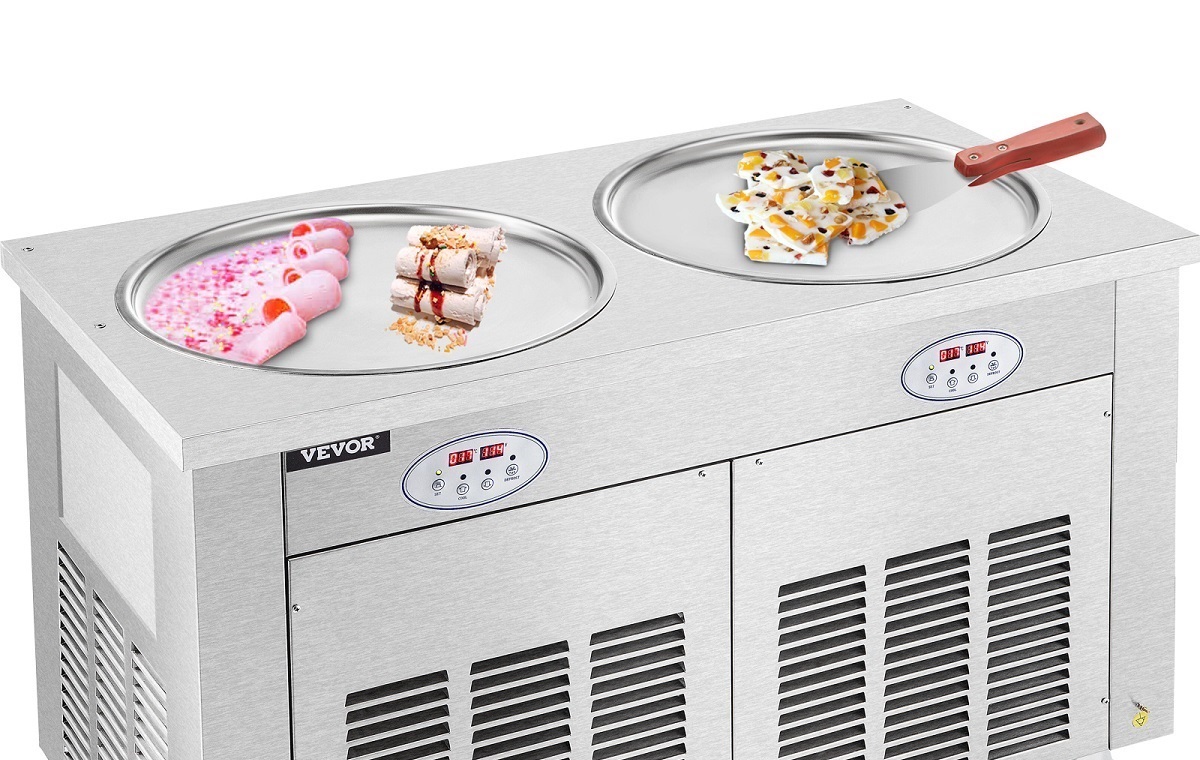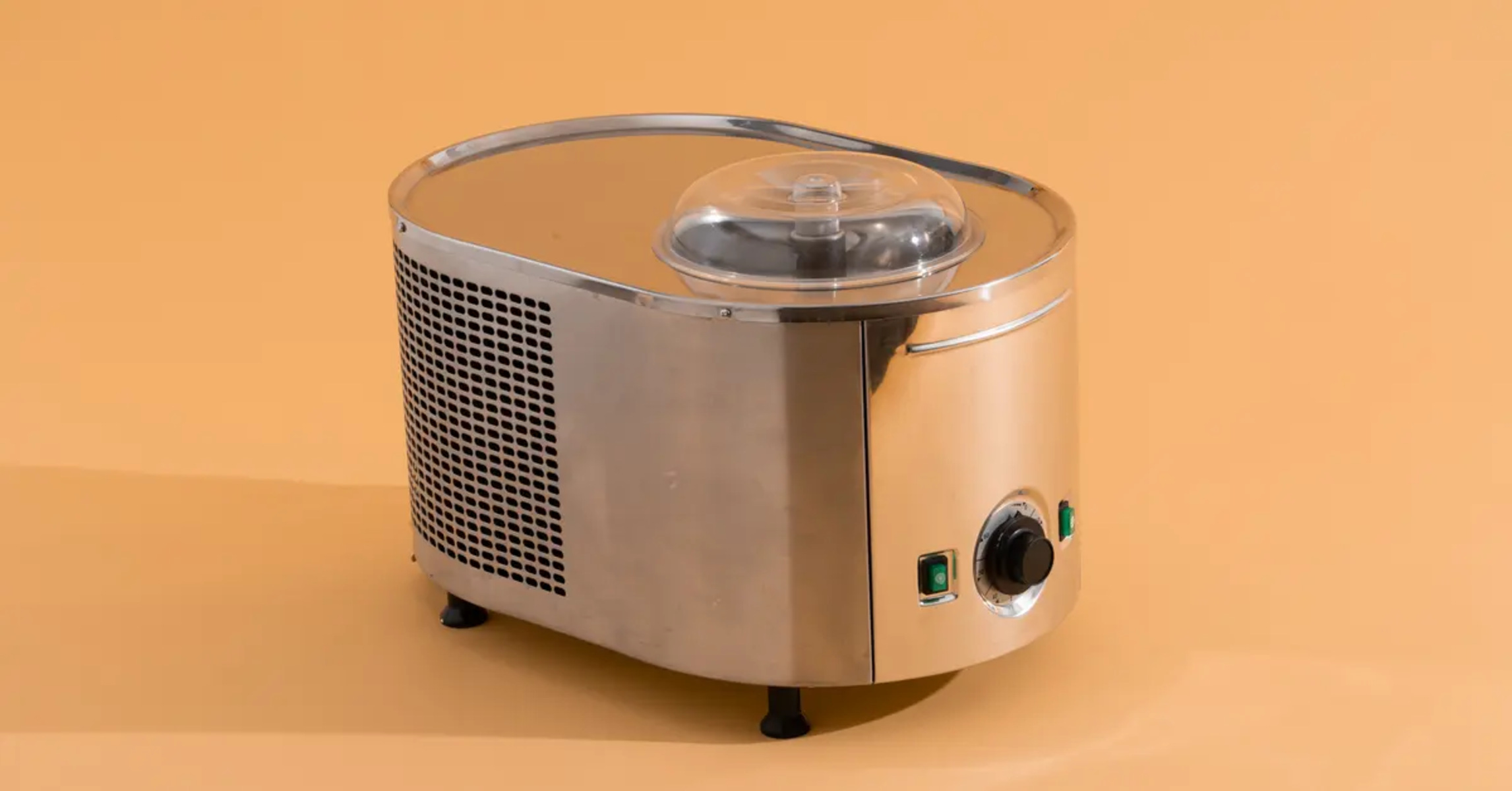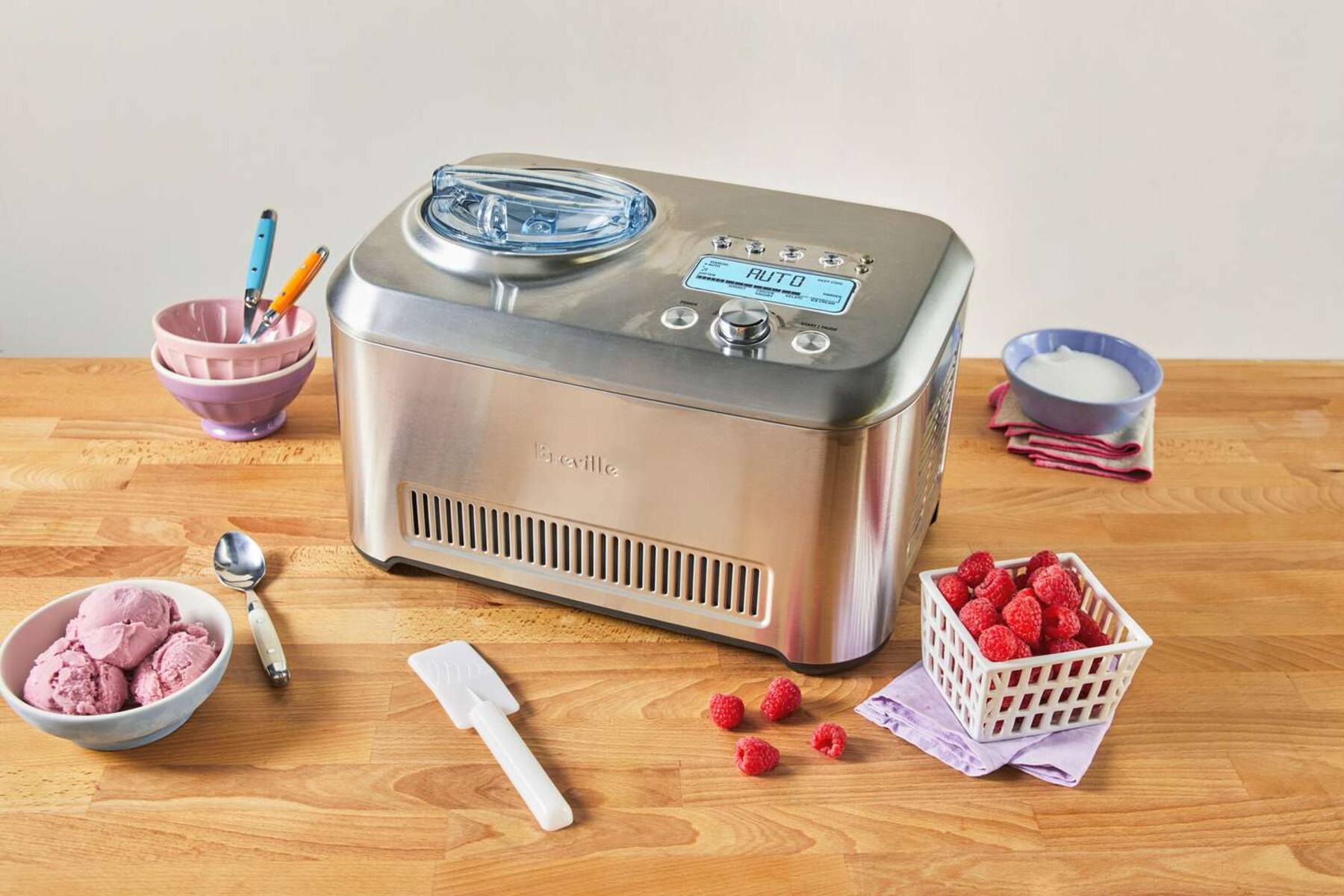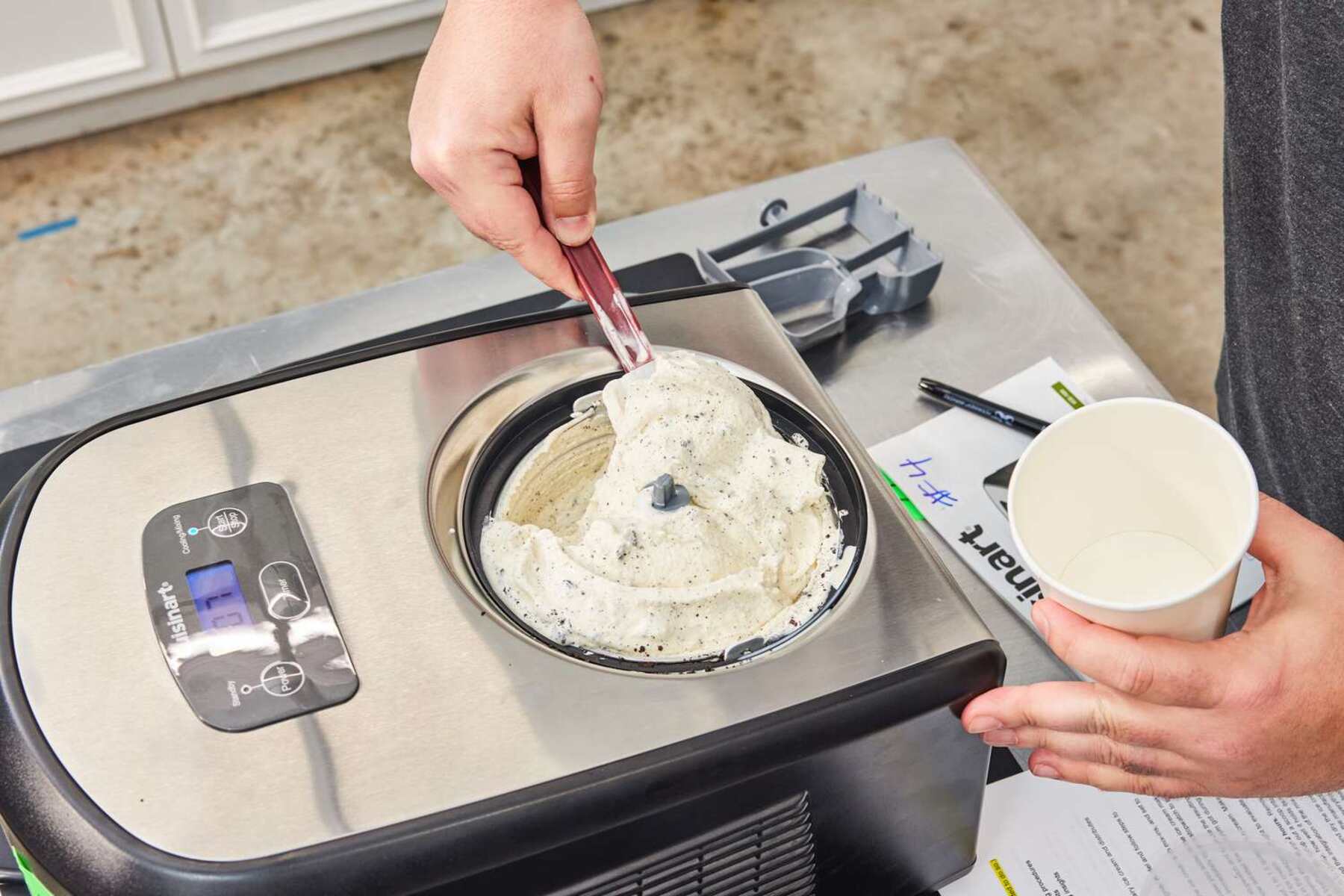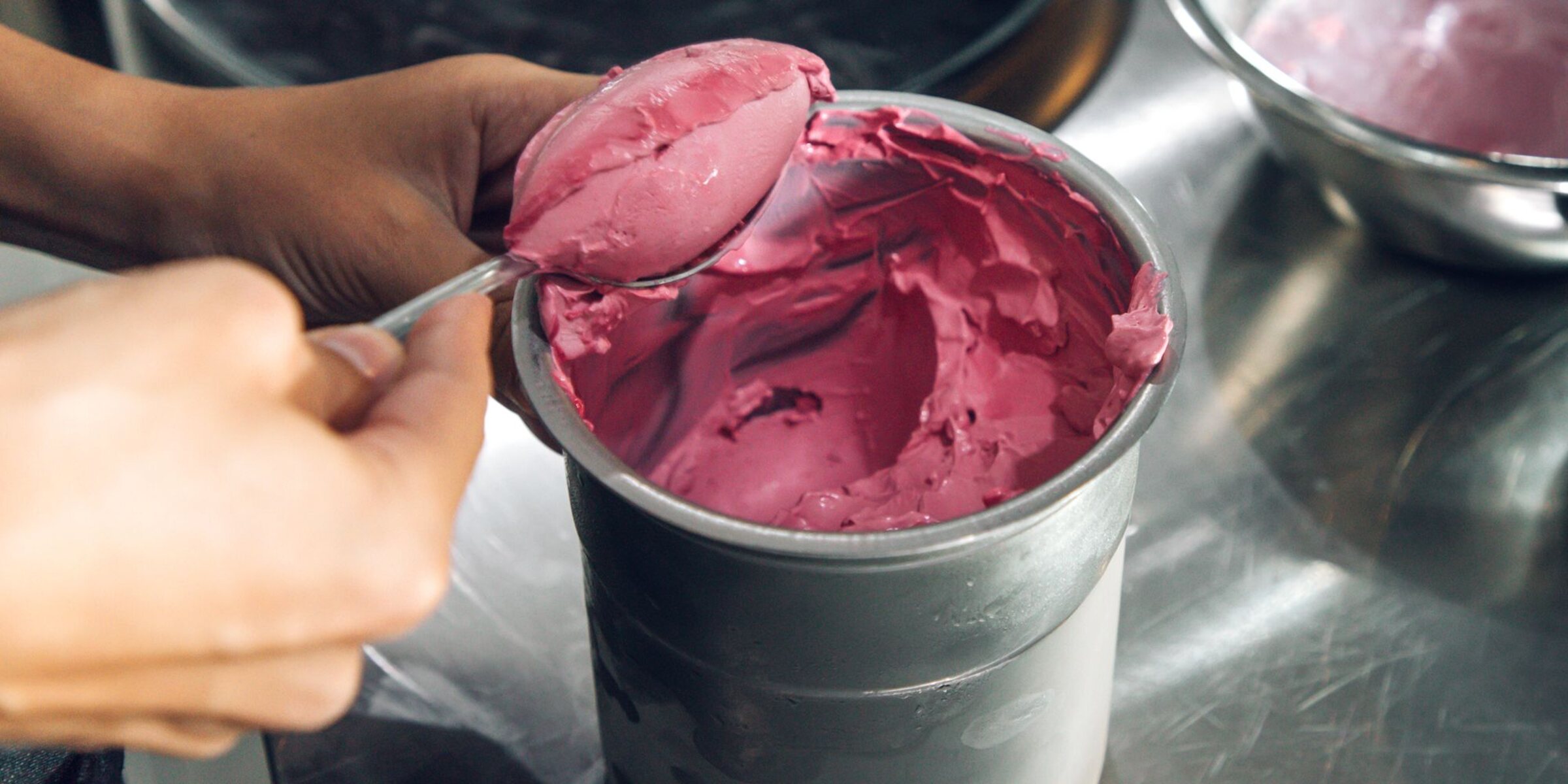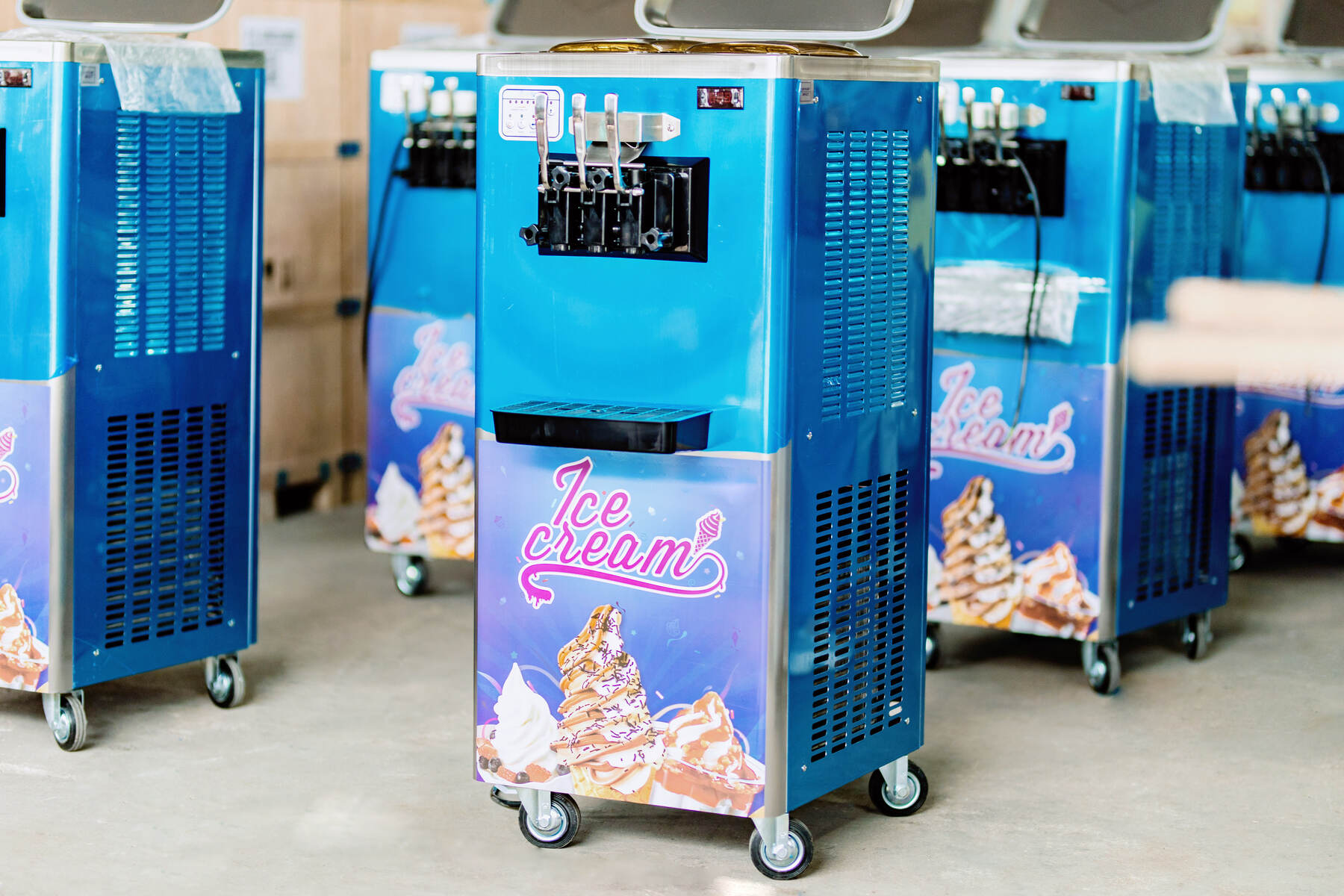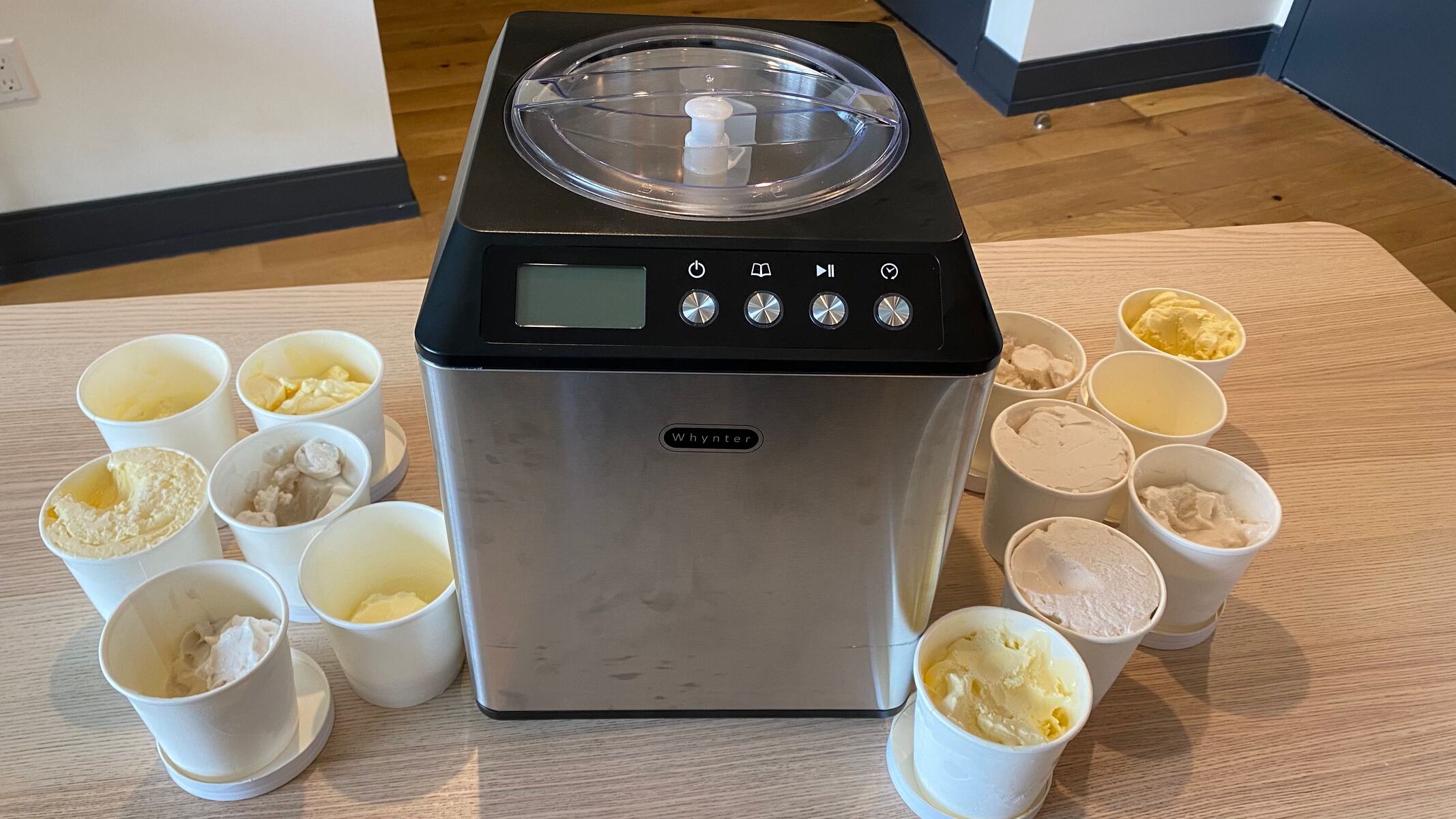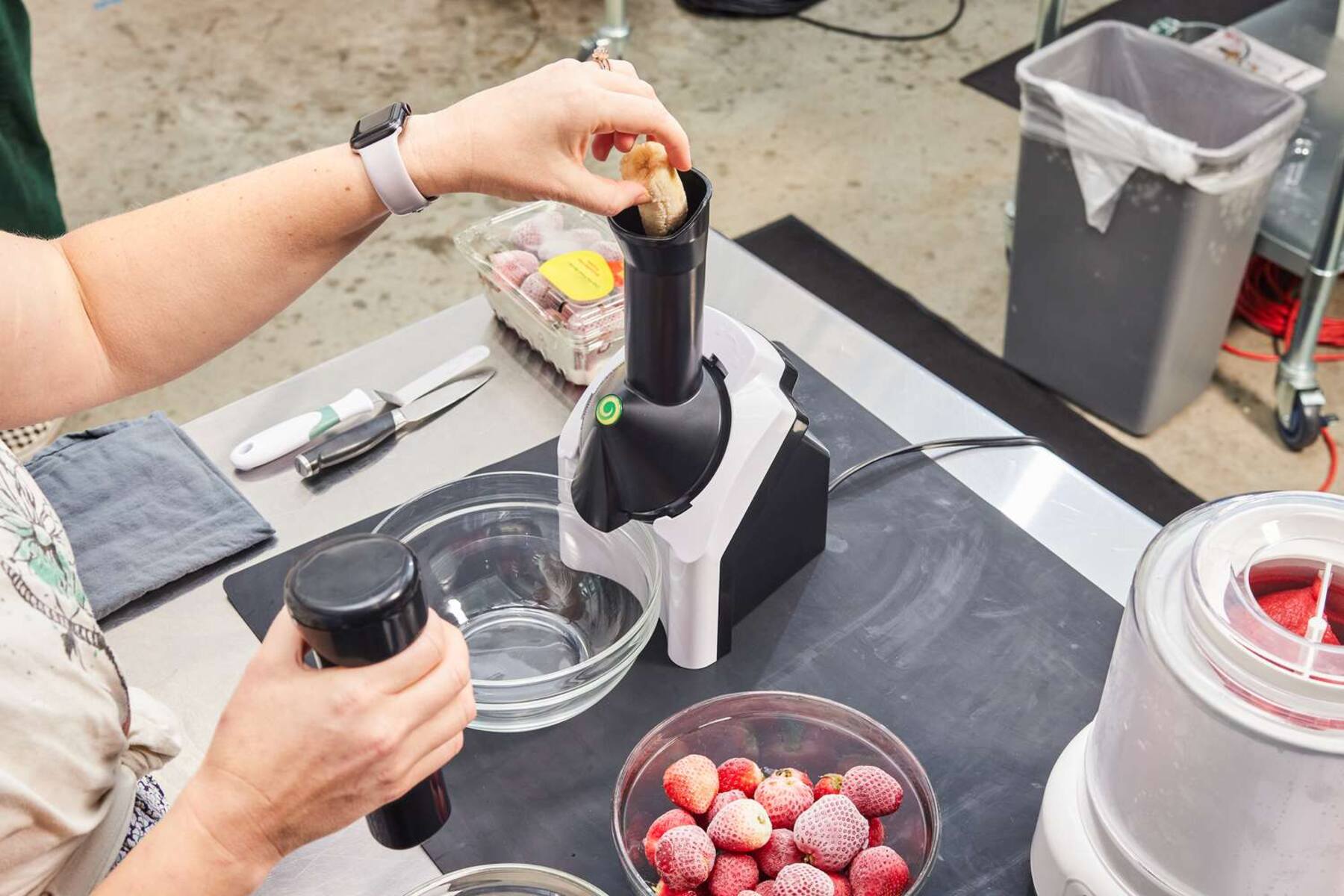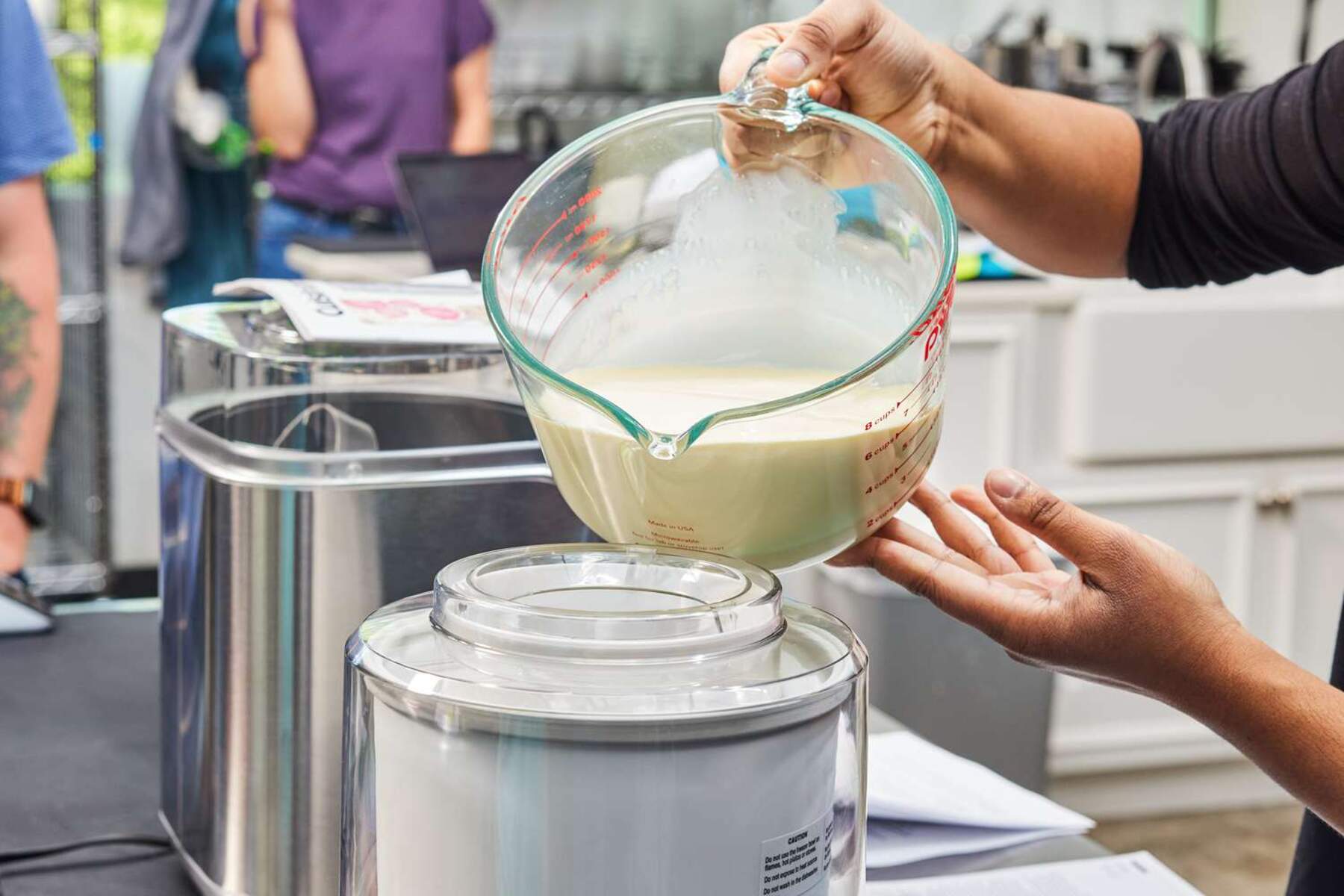Introduction
Ice cream lovers rejoice! There is a new trend in the world of frozen treats, and it’s called rolled ice cream. This unique dessert has taken the culinary scene by storm with its enticing presentation and delicious flavors. But have you ever wondered how rolled ice cream is made? Behind every mouth-watering rolled ice cream creation is a remarkable machine that makes it all possible.
Rolled ice cream is a popular dessert that originated in Thailand and quickly spread around the globe. It is made by pouring a liquid ice cream mix onto a chilled metal plate. The mix is then manipulated with spatulas and ingredients like fruits, cookies, or chocolate to create a perfectly smooth and creamy consistency. The mixture is spread out thinly on the plate and scraped into beautiful rolls using special techniques.
Rolled ice cream has gained immense popularity due to its visually appealing presentation and the ability to customize flavors and toppings. The process of making rolled ice cream is not only delicious to watch but also allows for endless creativity when it comes to flavor combinations.
Now, let’s dive into the world of rolled ice cream machines. These ingenious devices are the key to creating rolled ice cream with precision and efficiency. They are specially designed to freeze the ice cream mixture quickly, ensuring a perfectly creamy texture. But what are these machines called, and how do they work? Let’s find out!
What is rolled ice cream?
Rolled ice cream, also known as Thai rolled ice cream or stir-fried ice cream, is a type of frozen dessert that has gained widespread popularity in recent years. Unlike traditional scooped ice cream, rolled ice cream is made by pouring a liquid ice cream base onto a super-cooled metal plate. The mixture is then stirred and spread out until it solidifies into a thin layer. Using spatulas, the ice cream is skillfully scraped off the plate and rolled into delicate and visually appealing cylindrical shapes.
One of the things that make rolled ice cream so unique is its customizable nature. Since the mixture is poured onto the cold plate in liquid form, it allows for endless possibilities in terms of flavors and add-ins. From classic flavors like chocolate and vanilla to more exotic blends like matcha green tea or lavender, the options are limited only by the imagination of the ice cream maker.
The process of making rolled ice cream is not only entertaining to watch but also results in a smooth and creamy texture that is distinct from traditional ice cream. The rapid freezing on the cold plate ensures minimal ice crystal formation, resulting in a velvety consistency that melts in your mouth. The small rolls of ice cream are not only visually appealing but also make it easy to portion and serve, making rolled ice cream a perfect treat for sharing.
Rolled ice cream has become a popular choice for dessert lovers around the world. Its unique presentation, combined with the ability to customize flavors and add-ins, has made it a hit among food enthusiasts, social media influencers, and ice cream aficionados alike. Whether enjoyed as a single flavor or as a combo with an array of delicious toppings, rolled ice cream offers a delightful and satisfying sensory experience that is sure to please even the most discerning palates.
The popularity of rolled ice cream
In recent years, rolled ice cream has taken the dessert scene by storm, captivating the taste buds and hearts of ice cream enthusiasts worldwide. What started as a beloved street food treat in Thailand has now become a global dessert sensation, with dedicated rolled ice cream shops popping up in major cities.
One of the factors contributing to the popularity of rolled ice cream is its unique and Instagram-worthy presentation. The process of creating rolled ice cream right before your eyes is a feast for the senses, drawing in curious onlookers and generating excitement. The sight of freshly made ice cream being meticulously rolled and adorned with a variety of toppings is undeniably captivating and has made rolled ice cream a social media favorite.
Furthermore, rolled ice cream offers a level of customization that appeals to a wide range of tastes. With traditional scooped ice cream, the flavors and toppings are usually predetermined and mixed in advance. However, with rolled ice cream, customers have the opportunity to choose their own flavor combinations and watch as the ice cream is prepared in front of them. This interactive and personalized experience allows for a more tailored and adventurous dessert option.
The versatility of rolled ice cream also contributes to its popularity. With a flat, frozen surface and a liquid ice cream base, the possibilities for flavor combinations and add-ins are virtually endless. From classics like cookies and cream to innovative blends like salted caramel pretzel, rolled ice cream has something to satisfy every craving.
Additionally, the appeal of rolled ice cream extends beyond its taste and presentation. Many people appreciate the craftsmanship and skill involved in creating each roll. The technique requires precise spreading, scraping, and rolling, showcasing the proficiency and artistry of the ice cream maker. This level of attention to detail elevates the experience and adds a sense of novelty to the enjoyment of the dessert.
Overall, the popularity of rolled ice cream can be attributed to its visually stunning presentation, customizable flavor options, and the engaging process of its preparation. Whether enjoyed as a refreshing treat on a hot summer day or as a captivating indulgence any time of the year, rolled ice cream has captured the hearts and taste buds of dessert enthusiasts worldwide.
The machine used to make rolled ice cream
The process of making rolled ice cream requires a specialized machine that is designed to quickly freeze the liquid ice cream mixture. These machines consist of several key components that work together to create the perfect rolled ice cream texture and consistency.
The main element of a rolled ice cream machine is the metal plate. This plate is typically made of stainless steel and is chilled to extremely low temperatures, typically between -18°C to -35°C (-0.4°F to -31°F). The cold plate is essential for quickly freezing the liquid ice cream mixture once it is poured onto the surface.
Along with the cold plate, the machine is equipped with a refrigeration system that keeps the plate at the desired temperature. This system ensures that the plate remains consistently cold, allowing for efficient freezing of the ice cream mixture.
Another important component of a rolled ice cream machine is the electronic control panel. This panel allows the operator to adjust the temperature of the cold plate, as well as control the mixing and scraping speeds. The level of control over these variables helps achieve the desired consistency and texture of the rolled ice cream.
Furthermore, rolled ice cream machines are often equipped with multiple round or rectangular compartments on the cold plate, allowing for the simultaneous preparation of several different flavors. This feature is particularly useful for busy establishments that need to accommodate a variety of customer preferences quickly.
In addition to these core components, some rolled ice cream machines may come with additional features such as built-in refrigerated storage for mix-ins, a built-in water faucet for cleaning, or a storage cabinet for supplies. These convenient extras can streamline the process and make it easier to produce a high volume of rolled ice cream.
It is important to note that while the design and features of rolled ice cream machines may vary, the fundamental purpose remains the same – to freeze the liquid ice cream mixture quickly and efficiently. These machines have revolutionized the way we enjoy ice cream, allowing for endless customization and innovative flavor combinations that cater to the unique preferences of each individual customer.
Different names for rolled ice cream machines
The machine used to make rolled ice cream is known by various names, depending on the region and context. While the basic functionality remains the same, different terms are used to describe these innovative dessert-making devices.
In Thailand, where rolled ice cream originated, the machine is commonly referred to as an “ice pan.” This name reflects the flat metal plate on the machine, which resembles a traditional frying pan. The term “stir-fried ice cream machine” is also used due to the resemblance of the ice cream-making process to stir-frying in a hot pan.
In Western countries, the machine is often called a “rolled ice cream machine” or a “Thai rolled ice cream machine,” emphasizing the specific style of dessert it produces. These names are widely recognized and understood by dessert enthusiasts who are familiar with the trend.
In some commercial settings, the machine may be referred to as an “ice cream teppanyaki machine.” This name draws inspiration from the Japanese teppanyaki cooking technique, where food is prepared on a flat metal surface. The similarity between the teppanyaki griddle and the cold plate of a rolled ice cream machine has led to this association in certain contexts.
It is important to note that while these are the most common names for rolled ice cream machines, local variations and creative terms may also exist. Some establishments may even come up with their own unique names or branding for their specific machine models.
Regardless of the name used, rolled ice cream machines have become a staple in ice cream shops, food trucks, and dessert parlors around the world. The unique ability of these machines to rapidly freeze and roll the ice cream mixture has transformed the dessert-making process and introduced an exciting new way to enjoy this beloved treat.
How rolled ice cream machines work
Rolled ice cream machines are designed to freeze and manipulate the liquid ice cream mixture into thin rolls with the help of a super-cooled metal plate. The process involves several steps that work together to create the unique texture and presentation of rolled ice cream.
First, the machine’s refrigeration system cools the metal plate to a very low temperature, typically between -18°C to -35°C (-0.4°F to -31°F). This extreme coldness allows for rapid freezing of the liquid ice cream mixture and ensures the formation of small ice crystals, resulting in a smooth and creamy texture.
Next, the operator pours the liquid ice cream base onto the cold plate. The base can be a pre-made mixture or a custom recipe, depending on the preferences of the ice cream shop. Once on the plate, the mixture starts to solidify immediately due to the cold temperature of the surface.
Using specialized spatulas, the operator quickly chops, stirs, and mixes the mixture on the plate. This process incorporates any additional ingredients or flavors, such as fruits, cookies, or chocolate chips, into the ice cream base. As the mixture thickens, it is spread out evenly on the cold plate.
Once the mixture has reached the desired consistency, the spatulas are used to carefully scrape the frozen layer from the plate. The scraping action creates thin rolls of ice cream that are visually appealing and easy to serve. These rolls are delicately placed in a cup or bowl, ready to be adorned with toppings or enjoyed as is.
The speed and skill with which the operator works on the cold plate are essential to the process. The precise timing and technique ensure that the ice cream mixture freezes evenly and forms beautiful rolls without any excess melting or sticking to the plate.
Throughout the process, the machine’s electronic control panel allows the operator to adjust the temperature of the cold plate and control the mixing and scraping speeds. These controls provide flexibility and precision, allowing for variations in ice cream texture and consistency based on personal preferences or specific recipes.
Overall, rolled ice cream machines combine rapid freezing and manual manipulation to create the unique texture and presentation of rolled ice cream. By capitalizing on the cold plate’s freezing power and the operator’s skill, these machines have revolutionized the way ice cream is made and enjoyed, offering a visually stunning and customizable dessert experience for all.
The benefits of using a rolled ice cream machine
Using a rolled ice cream machine has numerous benefits for both businesses and ice cream enthusiasts. These machines offer a range of advantages that contribute to the popularity and success of rolled ice cream.
One of the primary benefits is the speed at which rolled ice cream can be made. The super-cooled metal plate of the machine allows for quick freezing of the liquid ice cream mixture, reducing the production time significantly. This efficient process is especially beneficial for busy ice cream shops or food trucks that need to serve a large number of customers within a short period.
Another advantage of using a rolled ice cream machine is the level of customization it offers. With a liquid ice cream base, various flavors and add-ins can be easily incorporated into the mixture. Customers can choose their preferred flavors and watch as the ice cream is made right in front of them. This interactive experience enhances customer satisfaction and allows for endless creative combinations.
The visual appeal of rolled ice cream is also a significant benefit. The unique presentation, with its perfectly rolled ice cream pieces arranged in a cup or bowl, captures attention and generates excitement among customers. This eye-catching display not only enhances the overall dessert experience but also makes for great social media content, helping to promote the business and attract new customers.
Rolled ice cream machines are also known for their efficiency in space utilization. Unlike traditional ice cream machines that require ample storage for pre-frozen tubs or containers, rolled ice cream machines only require a small footprint. This compact size makes them suitable for a variety of establishments, including food trucks, kiosks, and small ice cream shops with limited space.
Additionally, rolled ice cream machines have the advantage of easy cleaning and maintenance. The removable cold plate and stainless-steel construction make it simple to wipe down and sanitize, ensuring optimal hygiene for each batch of ice cream. This convenience is crucial for maintaining high food safety standards and operational efficiency.
Furthermore, using a rolled ice cream machine allows for portion control and reduced waste. The ability to create individual rolls allows for precise portioning, reducing the risk of over-portioning or waste. This helps businesses manage costs while providing customers with a satisfying and visually appealing dessert experience.
In summary, the benefits of using a rolled ice cream machine include faster production time, customization options, visually appealing presentation, efficient space utilization, easy cleaning and maintenance, and portion control. These advantages contribute to the popularity and success of rolled ice cream, making it an attractive choice for businesses and a delightful treat for ice cream enthusiasts.
Factors to consider when choosing a rolled ice cream machine
Choosing the right rolled ice cream machine is essential for businesses that want to offer this trendy dessert. Several factors should be considered when selecting a machine that will meet your specific needs and ensure a smooth and efficient operation.
First and foremost, consider the size and capacity of the machine. Determine the volume of rolled ice cream you expect to produce daily and choose a machine that can handle that demand. Smaller establishments may only need a compact machine with a single cold plate, while larger operations may benefit from machines with multiple cold plates to increase production capacity.
Next, assess the quality and durability of the machine. Look for machines made from high-grade materials, such as stainless steel, which is both hygienic and resistant to corrosion. A sturdy construction ensures the machine can withstand continuous use without deterioration, leading to a longer lifespan and a better return on investment.
Consider the temperature control options of the machine. The ability to adjust the cold plate temperature is crucial for achieving the ideal freezing point for your specific ice cream recipe. Look for machines with precise temperature controls to ensure consistent results and the desired texture of the rolled ice cream.
Ease of use and cleaning should also be taken into account. Look for machines with intuitive controls and a user-friendly interface. Additionally, check if the machine has easily removable and dishwasher-safe parts, such as the cold plate and spatulas, which will make cleaning and maintenance more efficient.
Ensure that the machine complies with safety regulations and certifications. Look for machines that are approved by relevant food safety authorities to ensure that they meet the necessary health and safety standards. This will provide peace of mind and ensure the safe production of rolled ice cream.
Consider the availability of spare parts and after-sales service. Look for reputable manufacturers or suppliers that offer reliable customer support and readily available spare parts. This will ensure that any potential issues can be quickly addressed and that the machine can be properly maintained and repaired as needed.
Lastly, factor in your budget and the overall value offered by the machine. While cost is an important consideration, it’s essential to strike a balance between quality, features, and price. Consider the long-term benefits and ROI that the machine can provide, rather than solely focusing on the upfront cost.
Taking these factors into account when choosing a rolled ice cream machine will help ensure that you select a machine that meets your specific requirements and provides a reliable and efficient solution for producing delicious rolled ice cream.
Tips for maintaining and cleaning a rolled ice cream machine
Proper maintenance and cleaning of a rolled ice cream machine are essential for ensuring optimal performance, prolonging its lifespan, and maintaining hygiene standards. Here are some helpful tips to keep your machine in top condition.
1. Regular cleaning: After each use, thoroughly clean the machine to prevent the buildup of residue and bacteria. Disconnect the power and carefully remove the cold plate and spatulas. Wash them with warm water and mild detergent, ensuring all traces of ice cream and ingredients are removed. Rinse well and allow them to air dry before reassembling.
2. Sanitization: To maintain hygiene, sanitize the cold plate, spatulas, and other removable parts regularly. Use a food-safe sanitizing solution or a mixture of water and vinegar to disinfect the components. Follow the manufacturer’s instructions for proper sanitizing procedures.
3. Deep cleaning: Periodically, perform a deep clean of the machine to remove any stubborn residues or mineral deposits. Consult the user manual for specific instructions on how to disassemble, clean, and reassemble different parts of the machine.
4. Lubrication: Check if the machine requires lubrication for smooth operation. Lubricate any moving parts or hinges with food-grade lubricant as recommended by the manufacturer.
5. Inspect for damage: Regularly inspect the machine for signs of damage or wear and tear. Address any issues promptly to avoid potential breakdowns or unsafe operation.
6. Temperature control: Keep an eye on the temperature control system of the machine. Regularly calibrate and adjust the settings as needed to ensure the cold plate maintains the desired temperature for freezing the ice cream mixture effectively.
7. Keep the surroundings clean: It is important to maintain cleanliness in the area where the machine is located. Keep the surrounding surfaces clean and free from spilled ingredients or debris that could potentially contaminate the ice cream or the machine itself.
8. Use quality ingredients: To prevent unnecessary strain on the machine and maintain its performance, use high-quality ingredients for preparing the ice cream mixture. Ingredients that are too thick or contain large solids can damage or clog the machine’s components.
9. Follow manufacturer’s guidelines: Refer to the user manual and follow the manufacturer’s guidelines for operating, cleaning, and maintaining the machine. Adhering to the manufacturer’s instructions will ensure proper usage and maximize the lifespan of the machine.
10. Regular servicing: Consider having the machine serviced or inspected by a professional technician on a regular basis. They can identify any potential issues or perform routine maintenance tasks that you may not be aware of.
By following these tips, you can ensure that your rolled ice cream machine remains in excellent condition, providing consistent performance and producing delightful frozen treats for years to come.
Conclusion
Rolled ice cream machines have revolutionized the way we enjoy this delectable frozen treat. With their ability to quickly freeze and manipulate the liquid ice cream mixture, these machines have brought the mesmerizing experience of watching ice cream being made to a whole new level. From the unique presentation to the endless flavor possibilities, rolled ice cream has captivated the taste buds and imaginations of people around the world.
When choosing a rolled ice cream machine, it is important to consider factors such as size, capacity, quality, ease of use, safety, and after-sales support. These considerations will ensure that you select a machine that suits your specific needs and delivers consistently delicious rolled ice cream.
Proper maintenance and cleaning of the machine are crucial for its longevity and hygiene. Regularly cleaning and sanitizing the machine, checking for damage, and following the manufacturer’s guidelines will help keep the machine in optimal condition and ensure the production of high-quality rolled ice cream.
Rolled ice cream machines have not only transformed the way we enjoy frozen desserts but have also created a delightful and interactive experience for ice cream lovers. Whether you are a business owner looking to introduce this trendy dessert or a consumer seeking to indulge in a unique and customizable treat, rolled ice cream machines are the key to unlocking a world of delicious creativity and visual spectacle.
So, whether you are savoring a classic flavor combination or marveling at the artistic creations of a skilled ice cream maker, enjoy every delectable bite of rolled ice cream and let your taste buds take a delightful journey through this frozen wonderland. Elevate your dessert experience with the magic of rolled ice cream machines and make memories that will melt in your mouth and last a lifetime.







